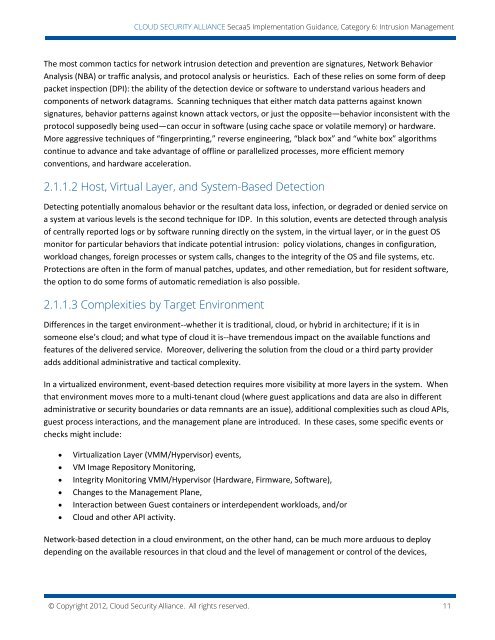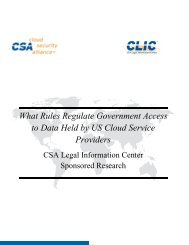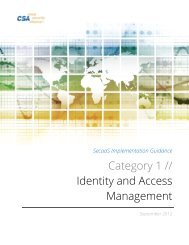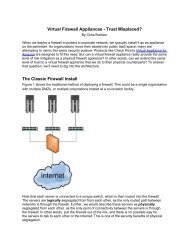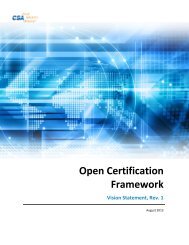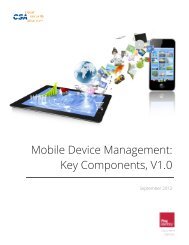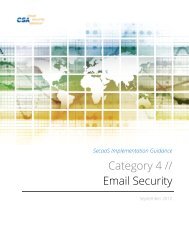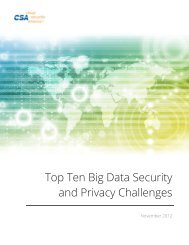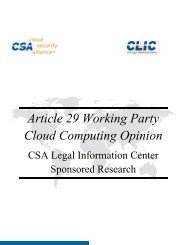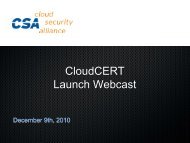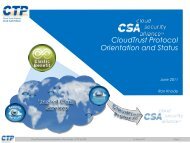Download - Cloud Security Alliance
Download - Cloud Security Alliance
Download - Cloud Security Alliance
- No tags were found...
Create successful ePaper yourself
Turn your PDF publications into a flip-book with our unique Google optimized e-Paper software.
CLOUD SECURITY ALLIANCE SecaaS Implementation Guidance, Category 6: Intrusion ManagementThe most common tactics for network intrusion detection and prevention are signatures, Network BehaviorAnalysis (NBA) or traffic analysis, and protocol analysis or heuristics. Each of these relies on some form of deeppacket inspection (DPI): the ability of the detection device or software to understand various headers andcomponents of network datagrams. Scanning techniques that either match data patterns against knownsignatures, behavior patterns against known attack vectors, or just the opposite—behavior inconsistent with theprotocol supposedly being used—can occur in software (using cache space or volatile memory) or hardware.More aggressive techniques of “fingerprinting,” reverse engineering, “black box” and “white box” algorithmscontinue to advance and take advantage of offline or parallelized processes, more efficient memoryconventions, and hardware acceleration.2.1.1.2 Host, Virtual Layer, and System-Based DetectionDetecting potentially anomalous behavior or the resultant data loss, infection, or degraded or denied service ona system at various levels is the second technique for IDP. In this solution, events are detected through analysisof centrally reported logs or by software running directly on the system, in the virtual layer, or in the guest OSmonitor for particular behaviors that indicate potential intrusion: policy violations, changes in configuration,workload changes, foreign processes or system calls, changes to the integrity of the OS and file systems, etc.Protections are often in the form of manual patches, updates, and other remediation, but for resident software,the option to do some forms of automatic remediation is also possible.2.1.1.3 Complexities by Target EnvironmentDifferences in the target environment--whether it is traditional, cloud, or hybrid in architecture; if it is insomeone else’s cloud; and what type of cloud it is--have tremendous impact on the available functions andfeatures of the delivered service. Moreover, delivering the solution from the cloud or a third party provideradds additional administrative and tactical complexity.In a virtualized environment, event-based detection requires more visibility at more layers in the system. Whenthat environment moves more to a multi-tenant cloud (where guest applications and data are also in differentadministrative or security boundaries or data remnants are an issue), additional complexities such as cloud APIs,guest process interactions, and the management plane are introduced. In these cases, some specific events orchecks might include:Virtualization Layer (VMM/Hypervisor) events,VM Image Repository Monitoring,Integrity Monitoring VMM/Hypervisor (Hardware, Firmware, Software),Changes to the Management Plane,Interaction between Guest containers or interdependent workloads, and/or<strong>Cloud</strong> and other API activity.Network-based detection in a cloud environment, on the other hand, can be much more arduous to deploydepending on the available resources in that cloud and the level of management or control of the devices,© Copyright 2012, <strong>Cloud</strong> <strong>Security</strong> <strong>Alliance</strong>. All rights reserved. 11


